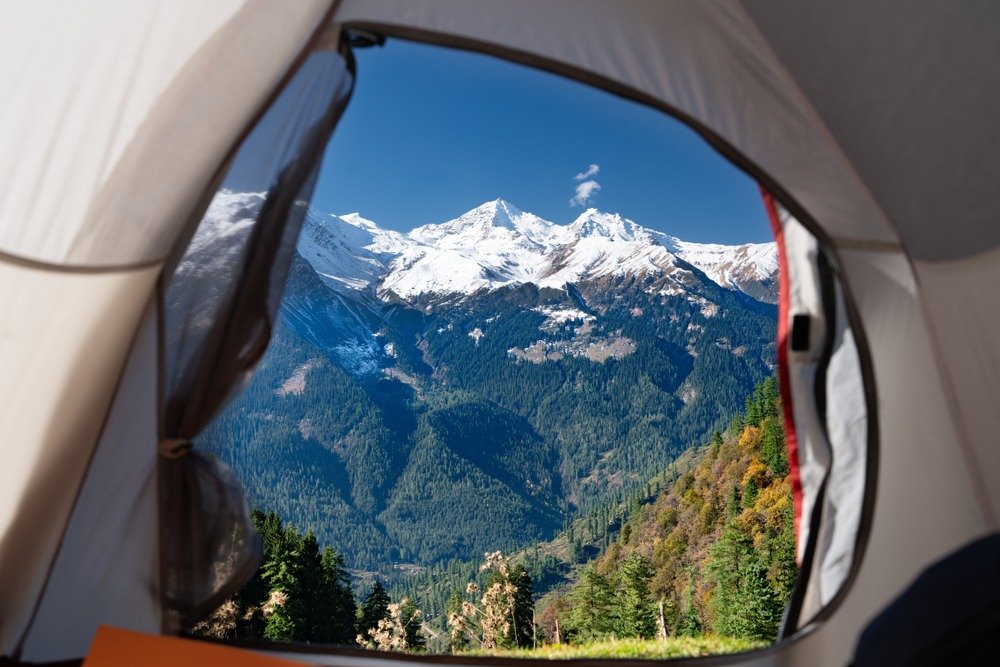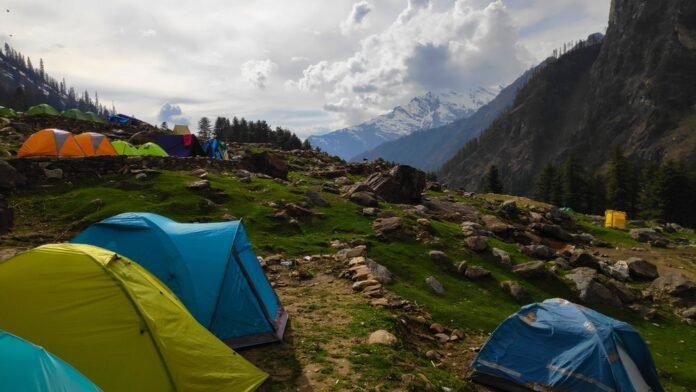Introduction: My First Kasol Trek and What I Wish I Had Known
The first time I embarked on the Kasol Trek, I was overwhelmed by the sheer beauty of the Parvati Valley. Every twist and turn revealed new sights—crystal-clear rivers, dense pine forests, and towering snow-capped peaks. But amidst all the excitement, there was one thing I hadn’t fully prepared for: packing. I thought I had everything I needed, but I quickly realized that a poorly packed bag could make a trek much more challenging than it should be. I discovered what functions well and what doesn’t with time. So, if you’re planning your own adventure to Kasol, here’s a guide to the top 10 essentials you absolutely need to pack to ensure a smooth and enjoyable trek.
1. Trekking Shoes That Make You Feel Like You Can Fly
There’s no better feeling than being confident with every step you take while trekking, and the right shoes are essential to achieving that. I still remember my first mistake—wearing regular sneakers on the uneven trails of Kasol. Not only did they offer zero ankle support, but their grip was non-existent, leading to a few close calls on slippery sections. After that experience, I invested in proper trekking shoes, and it made all the difference.
What you want is a pair of shoes that are waterproof and have a sturdy grip. They should also provide good ankle support, especially when navigating steep climbs or rocky paths. The waterproofing is a lifesaver when you unexpectedly find yourself crossing small streams or trekking through wet patches. Trust me—your feet will thank you after a long day of walking, and you’ll be able to enjoy the trek without worrying about every step.
2. A Backpack That Carries Your World Without Weighing You Down

Your backpack is more than just a bag—it’s your survival kit during the trek. But don’t make the mistake of overloading it, as I once did. During one of my earlier treks, I packed everything I thought I “might” need. By the end of the first day, my back and shoulders were aching. That’s when I learned the importance of choosing a good quality, lightweight backpack with just enough room for essentials.
I recommend a 40- to 50-liter backpack for the Kasol trek. This size is perfect for carrying all your gear without weighing you down. To ensure maximum comfort, look for a bag with belted waist and padded shoulder straps. By distributing the weight equally, these characteristics lessen the pressure on your shoulders and back. Another must-have is a rain cover. Kasol’s weather can be unpredictable, and a sudden downpour could ruin your gear if it’s not protected. A rain cover is an easy way to ensure that nothing gets wet.
3. Layered Clothing: Prepare for the Unpredictable
The changeable weather is one of the most exciting features of walking in the mountains. In Kasol, mornings can be chilly, afternoons warm, and evenings cold. I’ve learned that layering is the key to staying comfortable in these varying conditions. The first time I trekked, I wore a heavy jacket from the start, thinking it would keep me warm. But as the day progressed and the sun came out, I was drenched in sweat and uncomfortable.
Now, I always follow the layering principle. To keep sweat off your body, start with a base layer that wicks moisture away from it. Add a mid-layer, like a fleece or a wool sweater, for insulation, and top it off with a waterproof jacket that can protect you from wind and rain. The beauty of layering is that you can easily add or remove clothing as the temperature changes. This way, you’re always comfortable without having to carry around heavy gear.
4. Hydration is Everything—Carry Water Wisely
Trekking can be exhausting, and staying hydrated is crucial to maintaining your energy levels. I made the mistake once of not drinking enough water, thinking I would be fine until the next break. I wasn’t. Dehydration kicked in, and it made the rest of the trek far more challenging than it needed to be. Since then, I always prioritize hydration, no matter how short or long the trek is.
A hydration bladder is my preferred option because you can drink on the go without having to stop and fish out a water bottle. It’s convenient, especially when you’re trying to maintain a steady pace. However, carrying a refillable water bottle also works well. Just make sure you have water purification tablets or a portable filter if you’re planning to refill from natural sources. The streams and rivers in Kasol have some of the freshest water I’ve ever tasted, and being able to safely drink from them is a real bonus.
5. Snacks that Sustain You During Low Energy
Trekking requires a lot of energy, and while meal stops will help refuel you, you’ll need snacks to keep your energy levels up throughout the day. On my first long trek, I didn’t think much about snacks and relied on the meal breaks, but I quickly realized that small snacks between meals made a world of difference, especially on steep inclines.
I always bring a variety of portable, high-energy snacks with me so I can consume them on the run. My go-to items include nuts, protein bars, trail mix, and dried fruits. They provide an instant energy boost without adding too much weight to my backpack. Plus, they’re perfect for when you need a quick pick-me-up before tackling a tough climb or during a much-needed break to take in the view.
6. A Headlamp for Late-Night Adventures

One of my most unforgettable trekking experiences was watching the stars in Kasol at night. However, getting back to camp in the dark was a challenge because I hadn’t brought a proper headlamp. Since then, I’ve always packed a headlamp for any trek that could have me out after sunset. It’s not just for nighttime trekking but also handy for navigating your camp in the dark or early morning starts.
A headlamp is more convenient than a regular flashlight because it frees up your hands. Whether you’re setting up camp, reading a map, or just walking around at night, having both hands available makes everything easier. Make sure to carry extra batteries, though! There’s nothing worse than a dead headlamp in the middle of the wilderness.
7. First Aid Kit: The Small Pack That Can Save Your Trek
A first aid kit might be the last thing you think about when packing for a trek, but it’s one of the most important. I never used to think I’d need one until I got a nasty blister on one of my treks. Without a first aid kit, that small blister could have turned into a much bigger problem. Now, I always carry a compact kit that includes band-aids, blister pads, antiseptic wipes, and pain relievers.
It’s not just for blisters or minor cuts—having a first aid kit can also help with altitude sickness or minor muscle strains. I recommend adding in some ibuprofen or other pain relievers, and don’t forget any personal medications you might need. A small kit doesn’t take up much space, but it can make all the difference in keeping you healthy and comfortable on the trail. For anyone eager to explore the beauty of Kasol Trek, I highly recommend The Searching Souls. They prioritize safety and fun, ensuring that every trekker has a fantastic experience!
8. Sunscreen and Sunglasses—Your Shield Against the High-Altitude Sun
When trekking at high altitudes like Kasol, it’s easy to underestimate the sun’s intensity. My first experience trekking without proper sunscreen was a painful one. The sunburn I got after just a few hours in the mountains was worse than any beach vacation I’d ever been on! I learned my lesson, and now I never trek without proper sun protection.
A high-SPF sunscreen is a must, and you should apply it liberally on all exposed skin, including your face, neck, and hands. In addition to sunscreen, polarized sunglasses are essential. The glare from the sun, especially when it reflects off snow or water, can be blinding. A good pair of sunglasses will protect your eyes and make the trek much more enjoyable.
9. Portable Power Bank: Because You’ll Want to Capture Every Moment
Your phone may not have service in some parts of the Kasol trek, but that doesn’t mean you won’t need it. Between capturing stunning photos, navigating with maps, and using your phone as a flashlight or music player, battery life can drain faster than you expect. On one of my early treks, my phone died just as I reached one of the most picturesque spots. Since then, I always carry a portable power bank to ensure that never happens again.
A power bank can be a lifesaver, especially when you’re far from any charging points. Look for one with enough capacity to charge your devices multiple times. This way, you can keep your phone, camera, or GPS device powered throughout the trek without worry. After all, you don’t want to miss out on capturing the beautiful landscapes or staying in touch with your group.
10. Trekking Poles: Your Best Friend on Steep Terrain
At first, I thought trekking poles were only for seasoned hikers. But after trying them on a steep trek, I was hooked. Trekking poles can be incredibly helpful, especially when you’re navigating rough terrain or steep ascents and descents. They take some of the pressure off your knees and legs, making long treks more comfortable and reducing fatigue.
I recommend getting collapsible poles, as they’re easy to pack and carry when not in use. You might not need them on flat terrain, but they’re invaluable during steep climbs or descents. Plus, they help with balance, which can be tricky on rocky paths or slippery surfaces. Once you try them, you’ll wonder how you ever trekked without them.
Conclusion: Pack Smart, Trek Happy!
Trekking is all about enjoying the journey as much as the destination, and having the right gear ensures that you can focus on the experience rather than worrying about discomfort or missing essentials. By packing these 10 items, you’ll be well-prepared to tackle the Kasol Trek with confidence. Whether it’s the breathtaking views or the sense of accomplishment after a long day of trekking, being well-prepared allows you to fully immerse yourself in the adventure. So, pack smart, and get ready for an unforgettable experience in the heart of the Himalayas!
Please read more related topics like – What to Expect on Pindari Glacier Trek: Complete Itinerary

